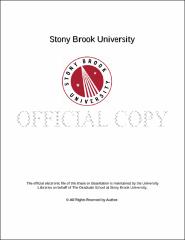| dc.identifier.uri | http://hdl.handle.net/11401/77134 | |
| dc.description.sponsorship | This work is sponsored by the Stony Brook University Graduate School in compliance with the requirements for completion of degree. | en_US |
| dc.format | Monograph | |
| dc.format.medium | Electronic Resource | en_US |
| dc.language.iso | en_US | |
| dc.publisher | The Graduate School, Stony Brook University: Stony Brook, NY. | |
| dc.type | Dissertation | |
| dcterms.abstract | Molecular Dynamics (MD) and Monte Carlo (MC) simulations of biomolecules have become a supportive tool to experimental methods for structure refinement, protein folding, drug discovery and many more applications. This is due to the increase in computational power and necessity of finding a method capable of describing the forces at work in chemical systems without the need to do extensive quantum calculations. All of these are possible because of the classical definition of the potential force field function. The force field function is essential to perform MD simulations, since this equation carries the physical description of the molecules being studied. Therefore, it is imperative to have a realistic force field. One of the most popular force field functions for the study of biomolecules is AMBER ff99SB. According to web of science, as of 2013 it has been referenced more than a thousand times. This popularity results from ff99SB's substantial agreement with NMR and X-ray crystallographic experimental findings. However, ff99SB is not perfect; there have been well-documented areas in which is in need of improvement. For example, helical propensities of transiently helical peptides are not being sampled nearly as much as suggested by experiments. The agreement between NMR observables for poly-alanine peptides and simulations needs to be further improved; as the results from simulations deviate from what is reported from experiment and agreement with poly-alanine vicinal scalar couplings has become one of the qualities for which force fields are commonly being evaluated. The backbone dihedral parameters were fitted to Quantum Mechanical (QM) energies of glycine and alanine tetra-peptides in AMBER ff99SB, as these tetra-peptides can helically hydrogen bond but isolate backbone effects from side-chains. Glycine and alanine populations better matched the Protein Data Bank (PDB) after this refinement. However, the dihedral maps did not match perfectly for each of the secondary structure regions of the Ramachandran map; indicating that there is still a gap between the results of QM calculations and what is observed in nature. This is because the secondary structure propensities of proteins in solution are governed by physical properties that cannot be completely reproduced by QM calculations of small homologous peptides in vacuum. Thus, it is necessary to empirically modify the energy function in order to overcome these limitations. In this work, we present a set of modifications to ff99SB force field backbone dihedral parameters, in particular to the φ ʹ , ψ and ψ ʹ corrections. Our goal was to further improve the agreement between results from simulations with backbone scalar couplings for poly-alanine peptides and helical propensities for transiently helical peptides. Furthermore, it would be ideal that these modifications do not alter significantly the propensities of the force field for other secondary structure regions in the dihedral map. We generated thirty potential modifications that were tested for agreement with J scalar couplings for Ala5 and Val3. We tested whether the same force field could improve scalar couplings and helical propensities by simulating two transiently helical peptides. We additionally evaluated the behavior of the force field with β -like peptides. The stability of protein simulations was estimated by calculating NMR order parameters from proteins. One of the modifications denoted mod1φ had good agreement with most of the experimental standards tested; indicating that the changes to the energy function can be applied to simulations of systems with diverse secondary structure. | |
| dcterms.available | 2017-09-20T16:52:03Z | |
| dcterms.contributor | Green, David | en_US |
| dcterms.contributor | Simmerling, Carlos | en_US |
| dcterms.contributor | Raleigh, Daniel | en_US |
| dcterms.contributor | Fernandez-Serra, Marivi. | en_US |
| dcterms.creator | Martinez, Carmenza | |
| dcterms.dateAccepted | 2017-09-20T16:52:03Z | |
| dcterms.dateSubmitted | 2017-09-20T16:52:03Z | |
| dcterms.description | Department of Chemistry. | en_US |
| dcterms.extent | 218 pg. | en_US |
| dcterms.format | Application/PDF | en_US |
| dcterms.format | Monograph | |
| dcterms.identifier | http://hdl.handle.net/11401/77134 | |
| dcterms.issued | 2014-12-01 | |
| dcterms.language | en_US | |
| dcterms.provenance | Made available in DSpace on 2017-09-20T16:52:03Z (GMT). No. of bitstreams: 1
Martinez_grad.sunysb_0771E_11714.pdf: 7650494 bytes, checksum: 2476c6afc4dc6bd9f7caa56194cd849b (MD5)
Previous issue date: 1 | en |
| dcterms.publisher | The Graduate School, Stony Brook University: Stony Brook, NY. | |
| dcterms.subject | AMBER, ff99SB, force field, molecular dynamics, molecular mechanics, protein simulations | |
| dcterms.subject | Bioinformatics | |
| dcterms.title | Enhanced Backbone Dihedral Parameters for Protein Simulations | |
| dcterms.type | Dissertation | |

